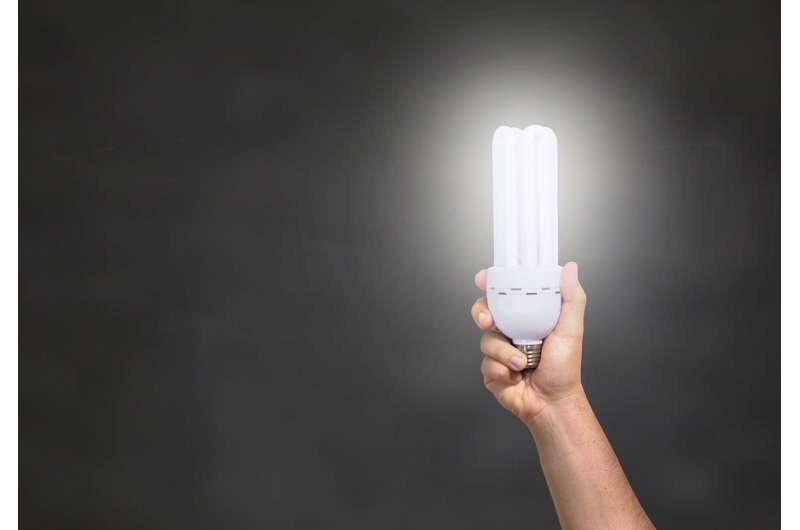This article has been reviewed according to Science X's editorial process and policies. Editors have highlighted the following attributes while ensuring the content's credibility:
fact-checked
trusted source
proofread
Study outlines cost, energy savings of switching from fluorescent lamps to LEDs

LED lighting is up to 44% more efficient than 4-foot fluorescent tubes, according to a University of Michigan study.
The study compared the costs of six replacement options (one fluorescent and five LED) for linear recessed lighting systems and found that LED products were 18%–44% more efficient than T8 fluorescent lamps.
The study was published online Nov. 10 in the journal Lighting Research & Technology.
Lighting is responsible for 11% of electricity use in commercial buildings and residential basements, garages and shops. Linear recessed lighting systems, which are also called linear fixtures or troffer lights, are among the largest opportunities for energy efficiency improvement, given their long operating hours.
The study's key takeaway is that switching to LEDs can save money and energy and reduce one's carbon footprint, according to senior study author Greg Keoleian, co-director of the Center for Sustainable Systems at the University of Michigan School for Environment and Sustainability.
"It's definitely better to replace your fluorescent lamps with LEDs rather than replace them with new fluorescent lamps," Keoleian said. "Our finding is consistent with the U.S. Department of Energy's indication that LED systems are 25% more energy-efficient than fluorescents."
LED lamps outperform fluorescent lamps in numerous ways, according to Keoleian. They produce light without flickering, have higher energy efficiency and last longer, which leads to improved ambiance, less maintenance and energy cost savings.
LEDs also offer better dimming performance than fluorescent lamps. They have faster ramp-up to full brightness and are more energy-efficient at low dimming levels. In addition, LEDs do not contain mercury, making them safer for indoor use and at end-of-life.
Keoleian and his team surveyed more than 160 LED replacement options, which included lamp replacements, retrofits and luminaire replacements. A lamp replacement is a change-out of the lamps only and does not require any electrical modification, while a retrofit involves modifying the existing fixture to accommodate a new light source and/or electronics. A luminaire replacement is a full change-out of the lighting system, including the mechanical structure.
The study authors compared the costs of six replacement options:
- Replacing a burnt-out fluorescent lamp with a new fluorescent lamp (not recommended)
- Replacing a fluorescent lamp with a plug and play Type A LED lamp (this requires no modification with the current unit and is compatible with electronic or magnetic ballasts)
- Hiring an electrician to retrofit an existing fixture and using a ballast bypass or direct-wire Type B LED lamp
- Using a hybrid Type AB LED lamp that works in an existing fixture or one where the ballast has been removed
- Buying a whole new recessed unit (luminaire) that uses an LED lamp that allows you to change the style and eliminates the need for a ballast replacement
- Buying a whole new recessed unit (luminaire) that uses an integrated non-replaceable LED lamp
Among their key findings:
- Plug and play, direct wire and hybrid LEDs are all more cost-effective and energy-efficient options for replacing fluorescent lamps.
- Plug and play LEDs (Type A) work in existing fixtures but ballasts may fail before the lamp. Their ease of installation can help spur LED adoption.
- Hybrid LEDs (Type AB) have the lowest upfront cost when an existing ballast is still usable.
- Direct-wire LEDs (Type B) are the lowest-cost option in terms of operation and maintenance costs and life cycle costs. They have relatively high installation costs.
- LED luminaires with replaceable lamps cost less than those with integrated non-replaceable lamps, though they offer fewer design options.
"These findings highlight tradeoffs when deciding between LED options and can help guide commercial building owners and managers who are considering lighting replacement," said Keoleian, who previously studied the energy and cost savings of replacing incandescent light bulbs with LEDs.
The exact savings depend on lamp costs, electricity rates and labor costs for an electrician if you are retrofitting or replacing the recessed fixture, Keoleian said. The LED options—except where you purchase a whole new lighting system (luminaire)—all result in cost savings over time. A whole new luminaire means a higher life cycle cost because of the higher upfront cost of a new unit.
The results are also applicable to residential buildings where T8 lamps and troffers are commonly used, particularly in workshops, basements and garages, Keoleian said.
More information: L Liu et al, Life cycle cost analysis of LED retrofit and luminaire replacements for four-foot T8 troffers, Lighting Research & Technology (2023). DOI: 10.1177/14771535231207810


















